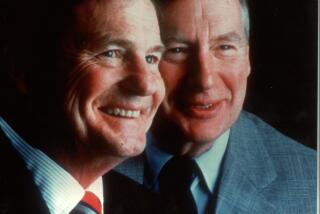William Safire dies at 79; speechwriter and Pulitzer-winning columnist
William Safire, a Pulitzer Prize-winning columnist and language maven for the New York Times, whose penchant for the barbed and memorable phrase first manifested itself in speeches he wrote for the Nixon White House, died Sunday at a hospice in Rockville, Md. He was 79.
Martin Tolchin, a longtime friend and former colleague at the Times, said Safire had been diagnosed with pancreatic cancer.
FOR THE RECORD:
William Safire obituary: The obituary of New York Times columnist William Safire in Section A on Sept. 28 said that former White House budget director Bert Lance, who was accused of irregular banking practices in Georgia, was acquitted on all counts by a federal grand jury. Lance was acquitted of nine counts, but the grand jury deadlocked on three others, and prosecutors decided against a retrial. —
For more than three decades, Safire wrote twice weekly as the resident conservative columnist on the Times op-ed page. He also wrote the popular “On Language” column in the New York Times Sunday Magazine, exploring grammar, usage and the origin of words. The column led to the publication of 10 books about words and language.
He arrived at the Times in 1973, fresh from his stint as a senior White House speechwriter for President Nixon. His catchy turns of phrase often outlived the context in which they were delivered. Perhaps the most memorable was the acidic and alliterative put-down he crafted for Vice President Spiro T. Agnew to describe those in the press who opposed the Vietnam War. They were, Agnew said, “nattering nabobs of negativism.”
Safire acknowledged in his inaugural column that his new role as a columnist sparked dismay among erstwhile colleagues.
“When word spread like cooling lava through the Nixon Administration that I was to become a columnist for the New York Times,” he wrote on April 15, 1973, “speechwriters who stayed behind wanted to know: ‘Will you continue to stand up for the President, the work ethic and the Nixon doctrine, or will you sell out to the elitist establishment and become a darling of the Georgetown cocktail party set?’ ”
Safire, who puckishly assured his readers he never ducked the tough questions, said that his answer to both questions was “yes and no.” He encouraged his readers “to watch this space for further development.”
His new colleagues in the Washington bureau of the Times also were suspicious, even a little hostile, Tolchin said. “They all thought that if there was to be a new column in the Times, they should be the one to write it,” he recalled.
The hostility disappeared at a party for the bureau when, as Tolchin recalled, the small son of reporter James Naughton fell into a swimming pool and a fully clothed Safire dived in to rescue him. “From that moment on, Bill was fully accepted by the bureau,” Tolchin said.
Witty, playful and always provocative, Safire quickly developed a voice of his own. In the words of William Greider, writing in the Washington Post in 1977, he was “a gaudy flame on display in a gray museum.”
Although his early columns defended Nixon against charges arising from Watergate, Safire became less ardent after he learned about the White House taping system. He won the Pulitzer Prize for commentary in 1978 for his columns on the financial affairs of Carter White House budget director Bert Lance, who was accused of irregular banking practices in Georgia. Lance resigned but was acquitted on all counts by a federal grand jury. He and Safire later became friends.
In the Reagan administration, he reported that Charles Z. Wick, head of the U.S. Information Agency, was secretly taping phone conversations.
“I’m willing to zap conservatives when they do things that are not libertarian,” Safire told the Washington Post in 2004. “I was the first to really go after George W. on his treatment of prisoners. . . . The wonderful thing about being a New York Times columnist is that it’s like a Supreme Court appointment -- they’re stuck with you for a long time.”
He was born William L. Safir (the “e” was added later) in New York City on Dec. 17, 1929. He enrolled at Syracuse University but dropped out after his sophomore year for financial reasons. At age 19, he caught on as a researcher and writer for New York Herald Tribune columnist Tex McCrary. He interviewed socialites, politicians and celebrities, including Mae West.
After working as a roving correspondent in Europe and the Middle East for WNBC radio and WNBT-TV, he was inducted into the Army, where he did public relations work. He made a name for himself by persuading NBC to televise nationally a Fourth of July ceremony awarding military decorations. He also arranged to have the ceremony at the foot of the Statue of Liberty, with a Navy aircraft carrier cruising in the background.
Returning to NBC in 1954, he produced the “Tex and Jinx” radio and TV shows, featuring Tex McCrary and his wife, Jinx Falkenburg. In 1955, he was named a vice president of Tex McCrary Inc., a public relations firm with clients including the construction company that built the “typical American house” for the American National Exhibition in Moscow.
Then-Vice President Nixon officially opened the exhibition on July 24, 1959. Safire was able to corral Nixon and Soviet leader Nikita S. Khrushchev in the kitchen showroom, where Nixon provoked the famous “kitchen debate” on the relative merits of capitalism and communism.
An Associated Press photographer, blocked by the crowd, tossed his camera to Safire over the heads of astonished Soviet guards, and the publicist snapped the famous photo of the two men engaged in their “debate.” The photo would be used to buttress Nixon’s reputation as a tough “cold warrior” in his 1960 presidential campaign against John F. Kennedy, the Democratic nominee.
Safire established his own public relations firm in 1961, whose clients included an ice cream company and a laxative manufacturer. He also worked on the Nixon-Lodge campaign in 1960 and on campaigns for New York Republicans Sen. Jacob Javits, Gov. Nelson Rockefeller and Mayor John V. Lindsay.
Looking toward the 1968 presidential campaign, Safire volunteered his services as an unpaid speechwriter on behalf of Nixon, who at the time had a law office in New York. Nixon assigned Safire to help Patrick J. Buchanan write Nixon’s syndicated newspaper column.
For the 1968 campaign, Safire wrote Nixon’s “new alignment” speech in which the candidate affirmed his belief that “the Republicans, the new liberals, the new South, [and] the black militants are talking the same language.” After Nixon’s election on Nov. 5, 1968, he wrote the president-elect’s victory speech, which included the major objectives of the new administration and the president’s determination “to bring the American people together.”
In February 1969, he moved into the White House as special assistant to the president, working under former Time Executive Editor James Keogh and as part of a team that included Buchanan and Raymond K. Price Jr. In a 1969 article, the New York Times described Safire as “the word factory’s resident pro for zingers and snappers.”
In 1970, Safire was detached from the president’s staff to write speeches for the vice president, including the famous “nattering nabobs of negativism” and “hysterical hypochondriacs.”
He continued writing his twice-weekly political column until 2005, his “On Language” until this month. He also wrote 15 books.
Survivors include his wife of 47 years, the former Helene Belmar Julius of Chevy Chase; two children, Mark Safire of Hastings-on-Hudson, N.Y., and Annabelle Safire of Rockville; and one granddaughter.
Holley writes for the Washington Post
More to Read
Start your day right
Sign up for Essential California for the L.A. Times biggest news, features and recommendations in your inbox six days a week.
You may occasionally receive promotional content from the Los Angeles Times.






